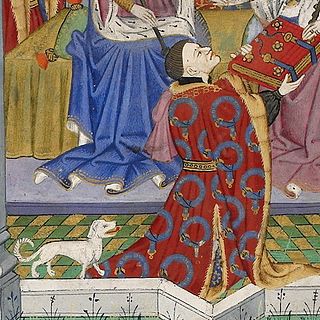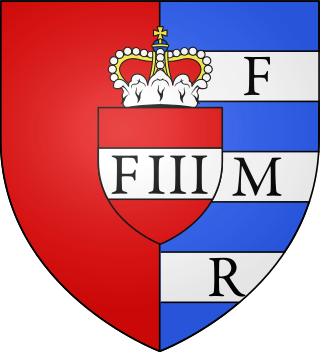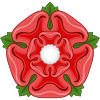
John Talbot, 1st Earl of Shrewsbury, 1st Earl of Waterford, 7th Baron Talbot, KG, known as "Old Talbot", was an English nobleman and a noted military commander during the Hundred Years' War. He was the most renowned in England and most feared in France of the English captains in the last stages of the conflict. Known as a tough, cruel, and quarrelsome man, Talbot distinguished himself militarily in a time of decline for the English. Called the "English Achilles" and the "Terror of the French", he is lavishly praised in the plays of Shakespeare. The manner of his death, leading an ill-advised charge against field artillery, has come to symbolize the passing of the age of chivalry. He also held the subsidiary titles of 10th Baron Strange of Blackmere and 6th Baron Furnivalljure uxoris.

Baron de Ros of Helmsley is the premier baron in the Peerage of England, created in 1288/89 for William de Ros, with precedence to 24 December 1264. Premier baron is a designation and status awarded to the holder of the most ancient extant barony of the Peerage of England. Before the Dissolution of the Monasteries the Prior of the Order of St John in England was deemed the premier baron.

Earl of Shrewsbury is a hereditary title of nobility created twice in the Peerage of England. The second earldom dates to 1442. The holder of the Earldom of Shrewsbury also holds the title of Earl of Waterford (1446) in the Peerage of Ireland and Earl Talbot (1784) in the Peerage of Great Britain. Shrewsbury and Waterford are the oldest earldoms in their peerages held by someone with no higher title, and as such the Earl of Shrewsbury is sometimes described as the premier earl of England and Ireland.

Baron Mowbray is a title in the Peerage of England. It was created by writ for Roger de Mowbray in 1283. The title was united with the Barony of Segrave in 1368, when John Mowbray, 1st Earl of Nottingham and 5th Baron Mowbray, succeeded to that title. His successor was named Duke of Norfolk. With the childless death of Anne Mowbray, 8th Countess of Norfolk, in c.1481, the Barony went into abeyance between the Howard and Berkeley families, and both styled themselves Baron Mowbray and Seagrave.

Baron Segrave (Seagrave) is a title in the Peerage of England. It was created by writ in 1283 for Nicholas de Segrave, and the title is drawn from a village in Leicestershire now spelled Seagrave.

Baron Petre, of Writtle, in the County of Essex, is a title in the Peerage of England. It was created in 1603 for Sir John Petre. His family has since been associated with the county of Essex. He represented Essex in parliament and served as Lord Lieutenant of Essex. Lord Petre was the son of Sir William Petre, Secretary of State to Henry VIII, Mary I, Edward VI and Elizabeth I. Sir William acquired Ingatestone Hall and the surrounding manor from Henry for the full market value after it had been surrendered to the King by Barking Abbey during the Suppression of the Monasteries.

Baron de Clifford is a title in the Peerage of England. It was created in 1299 for Robert de Clifford (c.1274–1314), feudal baron of Clifford in Herefordshire, feudal baron of Skipton in Yorkshire and feudal baron of Appleby in Westmoreland. The title was created by writ, which means that it can descend through both male and female lines. The Norman family which later took the name de Clifford settled in England after the Norman Conquest of 1066 and was first seated in England at Clifford Castle in Herefordshire. The first Baron served as Earl Marshal of England but was killed at the Battle of Bannockburn in 1314. His 8th generation descendant the 11th Baron, was created Earl of Cumberland in 1525, whose grandson the 3rd Earl was a noted naval commander. On the latter's death in 1605, the earldom passed to his younger brother, the 4th Earl.

Baron Dacre is a title that has been created three times in the Peerage of England, each time by writ.

Baron Strange is a title which has been created four times in the Peerage of England. Two creations, one in 1295 and another in 1326, had only one holder each, upon whose deaths they became extinct. Two of the creations, that of 1299 and that of 1628, are extant. The surname Le Strange was Latinized as Extraneus. The arms of Le Strange of Knockin Castle in Shropshire were: Gules, two lions passant argent.
Baron Lisle was a title which was created five times in the Peerage of England during the Middle Ages and Tudor period, and once in the Peerage of Ireland in the 18th century.

Baron Howard de Walden is a title in the Peerage of England. It was created by writ of summons in 1597 by Queen Elizabeth I for Admiral Lord Thomas Howard, a younger son of Thomas Howard, 4th Duke of Norfolk, by his second wife, the Honourable Margaret Audley, daughter of Thomas Audley, 1st Baron Audley of Walden.
Baron Beaumont is an ancient title in the Peerage of England, created in 1309 for a younger branch of the French counts of de Brienne family. The sixth Baron Beaumont was created Viscount Beaumont in 1432; after the death of his son the 2nd Viscount both titles fell into abeyance.
The title Baron Bergavenny was created several times in the Peerage of England and once in the Peerage of Great Britain, all but the first being baronies created by error. Abergavenny is a market town in South East Wales with a castle established by the Norman lord Hamelin de Balun c. 1087.

Edward Howard, 9th Duke of Norfolk was an English peer and politician who was Earl Marshal from 1732 to 1777.

Francis Talbot, 5th Earl of Shrewsbury, 5th Earl of Waterford, 11th Baron Talbot, KG was the son of George Talbot, 4th Earl of Shrewsbury, and Anne Hastings. He also held the subsidiary titles of 14th Baron Strange of Blackmere and 10th Baron Furnivall.

Gilbert Talbot, 7th Earl of Shrewsbury, 7th Earl of Waterford, 13th Baron Talbot, KG, styled Lord Talbot from 1582 to 1590, was a peer in the peerage of England. He also held the subsidiary titles of 16th Baron Strange of Blackmere and 12th Baron Furnivall.

John Talbot was the 2nd Earl of Shrewsbury, 2nd Earl of Waterford, 8th Baron Talbot, KG was an English nobleman and soldier and the son of John Talbot, 1st Earl of Shrewsbury, 1st Earl of Waterford, 7th Baron Talbot, 10th Baron Strange of Blackmere, and Maud Neville, 6th Baroness Furnivall.

The titles Baron Montacute or Baron Montagu were created several times in the Peerage of England for members of the House of Montagu. The family name was Latinised to de Monte Acuto, meaning "from the sharp mountain"; the French form is an ancient spelling of mont aigu, with identical meaning.
Baron Strange of Blackmere is an abeyant title in the Peerage of England. It was created on 13 January 1309 when Fulk le Strange was summoned to parliament. On the death of the fifth baron in 1375, it was inherited by Elizabeth Mowbray, née le Strange. On her death in the year 1383, it was inherited by Ankaret Talbot, née le Strange, daughter of the fourth Baron. On her son's death in 1419, the baron was inherited by Ankaret Talbot, his daughter. On her death in 1421, the barony was inherited by her uncle, John Talbot who was created Earl of Shrewsbury, Earl of Waterford and hereditary Lord High Steward of Ireland. On the death of the 7th earl in 1616, the barony fell into abeyance between his three daughters Mary, Elizabeth and Alethea. In 1651 Alethea became sole heir and therefore, Baroness Strange of Blackmere. The title continued in her descendants until the death of Edward Howard, 9th Duke of Norfolk and 22nd Baron Strange of Blackmere in 1777, when it again fell into abeyance. The co-heirs are the descendants of his nieces Winifred, Lady Stourton, and Ann, Lady Petre.

Baron Talbot is a title that has been created twice. The title was created first in the Peerage of England. On 5 June 1331, Sir Gilbert Talbot was summoned to Parliament, by which he was held to have become Baron Talbot.













